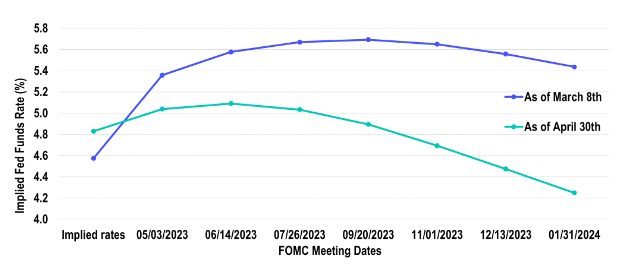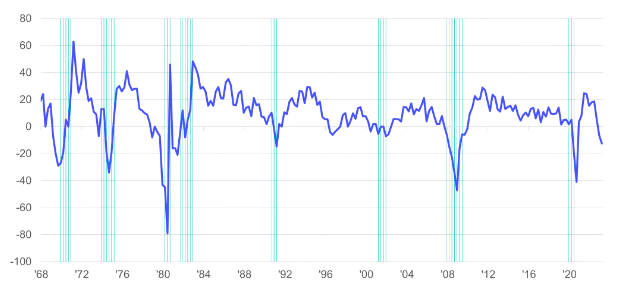12 Jun 2023
The longer-term risks of sticky inflation, monetary policy changes and slowing economic growth continue to challenge the markets. Within this uncertain backdrop, Franklin Income Investors’ Ed Perks shares his latest outlook and the investment opportunities he sees across fixed income and equities.
At its May policy meeting, the Fed raised the fed funds rate 25 basis points (bps) to a target range of 5.00%–5.25%. Looking back, the Fed has raised rates 500 bps in around 14 months, which is not only substantial in terms of the amount of tightening, but in the pace as well. We are clearly seeing how this tightening cycle has impacted the more interest-rate sensitive areas of the economy, such as housing, but also how it has caused strains in the banking system.
We believe the May increase could be the last we will see in this tightening cycle—at least for some time. There is clear evidence that economic slack is building within the US economy, and we believe the Fed has sufficiently moved into restrictive territory on a path to achieve its 2% inflation target. In addition, lending conditions are also tightening and doing some of the work for the Fed. The markets are now pricing in three to four rate cuts through the Fed meeting in January 2024. We are a little bit more cautious about this, though, and believe the Fed needs more time to take a pause and see how conditions evolve in the overall economy before acting.
Implied Rate – Fed Funds Futures
As of March 8, 2023 (Pre-Silicon Valley Bank Collapse) vs. April 30, 2023

Sources: FactSet, S&P Dow Jones Indices, FactSet Market Aggregates. As of April 30, 2023. There is no assurance that any estimate, forecast or projection will be realized.
Although the initial decline from the peaks for both headline and core inflation came relatively quickly, which set the market up for an expectation of the Fed getting closer to its target, we are finding that there is still substantial excess liquidity in the economy. Consumer spending is starting to wane, but core inflation—both Consumer Price Index (CPI) and Personal Consumption Expenditures (PCE)—is proving to be stickier and a challenge for the Fed. The labor market has so far continued to be resilient, putting upward pressure on wages. We think progress is being made, but it will be closer to the fourth quarter of 2023 where we might see real evidence that core prices are getting to the point where the Fed can start to contemplate removing its restrictive policy and get a bit more neutral. With loans contracting a little bit, particularly within regional banks, small- and medium-sized businesses will likely see a greater negative impact.
Senior Loan Officer Survey: Bank’s Willingness to Make Consumer Loans Now vs. Three Months Ago
As of March 31, 2023

Sources: FactSet, S&P Dow Jones Indices, FactSet Market Aggregates. As of March 31, 2023.
Following JPMorgan Chase’s recent acquisition of First Republic Bank, which was the fourth US bank failure in just the past two months, market participants are understandably concerned about volatility in the banking sector. Clearly, interest-rate hikes have caused balance-sheet distress for some banks—Silicon Valley Bank and First Republic Bank being two high-profile examples. Whenever there are these kinds of shocks, it is reasonable to expect some banks with poor risk controls or aggressive growth policies will be affected. However, we do not see the recent turmoil in regional banks as reflective of the health of the overall banking system.
In the second half of 2022, we had a big rotation in our strategy from equity into fixed income. Compared with what has been a traditional 60% equity/40% fixed income allocation, we flipped to a 60% fixed income/40% equity split. In the 15 years following the financial crisis, interest rates increased sharply as the Fed went from zero to neutral to sufficiently restrictive in a short span of time. This caused a big dislocation in the broader fixed income market, with yields moving to 4% to 5% as of March 31, 2023, versus yields around 2.5% in the prior decade.1 This rapid rate move has been a game changer and a great opportunity for us, especially given the current uncertain macroeconomic environment.
Going forward, we believe the attractiveness of the income from bonds remains important, as is the ability of these securities to be more defensive than other risk assets. Specifically, we will continue to focus on potential opportunities in investment-grade corporate credit if the asset class continues to offer what we consider attractive yields and total return potential. US Treasuries will also likely continue to be a core part of our strategy as they offer downside risk management against potential market drawdowns.
We have seen parts of the equity market perform relatively well during the first quarter of this year. However, looking toward the later part of 2023 and into 2024, we expect that corporate earnings will be flat or possibly even slightly negative. While there has been resilience so far, companies are showing signs of increasing difficulty generating growth. One reason is slower economic growth. Although a lot of companies have continued to show positive dynamics related to pricing, or their mix of products and services, revenues are starting to come down a little bit. Additionally, higher costs have caused a weakening in margins.
We believe there are more existing headwinds than tailwinds for equities, and the economic background remains uncertain. Thus, we are very cautious about adding incremental equity exposures at this time.
Within equities, we look not only at the macro setting and our expectations for the economy and markets, but we also dive down into opportunities in different sectors as there is tremendous dispersion within the markets. Sectors that outperformed last year—such as utilities, health care and consumer staples—have declined so far this year. In our opinion, there is nothing wrong with these types of companies, but we prefer longer-duration corporate bonds, which offer higher yields and discounts to par. This has been a big part of our shift toward greater fixed income exposure. Within fixed income, we favor health care, but we maintain a broad sector diversification within both fixed income and equity.
In our analysis, the markets are offering us good opportunities to diversify right now, and we believe sector diversification is a key way to help manage the overall risk in our strategy.
Contributors: Edward D. Perks, CFA, Chief Investment Officer, Franklin Income Investors
Endnote
1 Source: Bloomberg, as of March 31, 2023. Broader fixed income market represented by the Bloomberg US Aggregate Bond Index, which is a broad base, market capitalization-weighted bond market index representing intermediate-term investment-grade bonds traded in the United States. Indexes are unmanaged and one cannot directly invest in them. They do not include fees, expenses or sales charges. Past performance is not an indicator of future results. See www.franklintempletondatasources.com for additional data provider information.
All investments involve risks, including possible loss of principal. The value of investments can go down as well as up, and investors may not get back the full amount invested.
Stock prices fluctuate, sometimes rapidly and dramatically, due to factors affecting individual companies, particular industries or sectors, or general market conditions.
Bond prices generally move in the opposite direction of interest rates. Investments in lower-rated bonds include higher risk of default and loss of principal. Thus, as prices of bonds in an investment portfolio adjust to a rise in interest rates, the value of the portfolio may decline. Changes in the credit rating of a bond, or in the credit rating or financial strength of a bond’s issuer, insurer or guarantor, may affect the bond’s value. High yields reflect the higher credit risk associated with these lower-rated securities and, in some cases, the lower market prices for these instruments.
IMPORTANT LEGAL INFORMATION
This material is intended to be of general interest only and should not be construed as individual investment advice or a recommendation or solicitation to buy, sell or hold any security or to adopt any investment strategy. It does not constitute legal or tax advice.
The views expressed are those of the investment manager and the comments, opinions and analyses are rendered as at publication date and may change without notice. The information provided in this material is not intended as a complete analysis of every material fact regarding any country, region or market. All investments involve risks, including possible loss of principal.
Data from third party sources may have been used in the preparation of this material and Franklin Templeton ("FT") has not independently verified, validated or audited such data. FT accepts no liability whatsoever for any loss arising from use of this information and reliance upon the comments opinions and analyses in the material is at the sole discretion of the user.
Products, services and information may not be available in all jurisdictions and are offered outside the U.S. by other FT affiliates and/or their distributors as local laws and regulation permits. Please consult your own financial professional or Franklin Templeton institutional contact for further information on availability of products and services in your jurisdiction.
Issued by Franklin Templeton Investment Management Limited (FTIML). Registered office: Cannon Place, 78 Cannon Street, London EC4N 6HL. FTIML is authorised and regulated by the Financial Conduct Authority.
Investments entail risks, the value of investments can go down as well as up and investors should be aware they might not get back the full value invested.